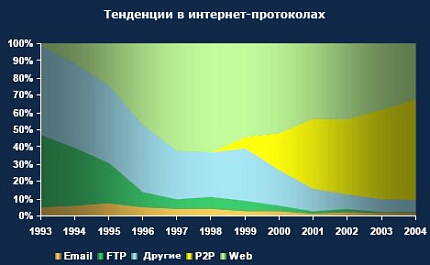Equality Wins Online
The volume of entertaining information that was poured on visitors at the Web 2.0 Summit conference held in early November in San Francisco seemed to be so huge that until now, even a month after it ended, the summit participants continue to rake and digest numerous presentations and reports.
Richard MacManus, definitely one of the most important people in the history of the IT industry in recent years, in his blog often highlights the latest trends in the development of the Network. He could not overlook the presentation of the British company CacheLogic , which works with network content and service providers, giving both of them a better look at the needs and capabilities of each other.
This wonderful presentation puzzled McManus a lot and, admittedly, not without reason. The main thing is that the “classic” (if you can talk like that about things invented less than 30 years ago) data transfer protocols are more and more inferior to the young growth of Peer-2-Peer.
')

Despite all the lawsuits and other obstacles from media companies that traditionally act as the main opponents of peer-to-peer technologies, it is obvious that from the very moment of their appearance, P2P networks started a triumphant march around the planet, winning more and more new territories. Already in 2004, the share of BitTorrent, eDonkey 2000 and FastTrack network traffic in the total data stream transmitted over the Network exceeded 60%, taking precedence from the Web protocol, and continues to grow.
Naturally, this is primarily due to the purpose for which P2P networks are used by Internet users - video downloading (62%), audio (11%) and other heavy files on average more than 100 MB in size, for example, distributions of various software. But CacheLogic insists that the love for this kind of file sharing extends in breadth, capturing fans among the widest masses, and not just among advanced techies.
The main conclusions that are made in the study are obvious, but they are no less significant. In the future, the Internet is waiting for an intensive expansion of the infrastructure capacity, updating the existing one and launching a new technology. This is for the service part. Content providers should pay more attention to P2P, which is still not suffering from its attention, surplus.
Earlier we wrote about a large batch of investments that BitTorrent Inc. received. And, apparently, this is only the first drop of the huge flow of money that will fall on this sector of the IT industry in the coming years.
Richard MacManus, definitely one of the most important people in the history of the IT industry in recent years, in his blog often highlights the latest trends in the development of the Network. He could not overlook the presentation of the British company CacheLogic , which works with network content and service providers, giving both of them a better look at the needs and capabilities of each other.
This wonderful presentation puzzled McManus a lot and, admittedly, not without reason. The main thing is that the “classic” (if you can talk like that about things invented less than 30 years ago) data transfer protocols are more and more inferior to the young growth of Peer-2-Peer.
')

Despite all the lawsuits and other obstacles from media companies that traditionally act as the main opponents of peer-to-peer technologies, it is obvious that from the very moment of their appearance, P2P networks started a triumphant march around the planet, winning more and more new territories. Already in 2004, the share of BitTorrent, eDonkey 2000 and FastTrack network traffic in the total data stream transmitted over the Network exceeded 60%, taking precedence from the Web protocol, and continues to grow.
Naturally, this is primarily due to the purpose for which P2P networks are used by Internet users - video downloading (62%), audio (11%) and other heavy files on average more than 100 MB in size, for example, distributions of various software. But CacheLogic insists that the love for this kind of file sharing extends in breadth, capturing fans among the widest masses, and not just among advanced techies.
The main conclusions that are made in the study are obvious, but they are no less significant. In the future, the Internet is waiting for an intensive expansion of the infrastructure capacity, updating the existing one and launching a new technology. This is for the service part. Content providers should pay more attention to P2P, which is still not suffering from its attention, surplus.
Earlier we wrote about a large batch of investments that BitTorrent Inc. received. And, apparently, this is only the first drop of the huge flow of money that will fall on this sector of the IT industry in the coming years.
Source: https://habr.com/ru/post/4806/
All Articles